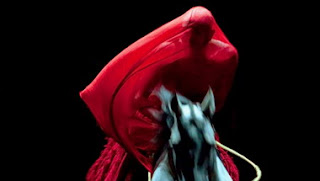 |
| Le Tintoret & Bartabas |
 |
| Ko Murobushi |
 |
| Impressive |
The horses sometimes performed without reins, and once without a rider. The rider (Bartabas) was on the floor, performing a very dramatic 'arising from the earth' sort of dance. The horse came over and began licking his arms and hands, and nuzzling him. No one was sure if this was part of the show, or just the horse being sweet. Or perhaps these sort of equine improvs are meant to be part of the show. It looked good, just a little distracting, perhaps.
There was a particularly dramatic bit where Bartabas stood in front of the dark horse (if you'll excuse the phrase) to create the impression that he was a man with a horse's head (a Centaur - geddit?). That was very well done - visually arresting.
 |
| Dark. Revolting. In a poetic kind of way. You had to be there. |
Having spent an evening listening to a bit of it, I'd say that's a pretty fair warning.God grant that the reader, emboldened and having become at present as fierce as what he is reading, find, without loss of bearings, his way, his wild and treacherous passage through the desolate swamps of these sombre, poison-soaked pages; for, unless he should bring to his reading a rigorous logic and a sustained mental effort at least as strong as his distrust, the lethal fumes of this book shall dissolve his soul as water does sugar.
 |
| Bartabas in full flight. |
There's not much more to tell you about the performance, except that I'm glad I overcame my prejudices and went to see some dance. The Butoh stuff was enthralling and visceral, and the horses were darling. The lighting designer needs to get a mention - thank you Francoise Michel - because with one of those plain dance sets the lighting was needed, and superb. The audience was fairly appalling. I have never heard so much coughing in my life (might be the time of year - colds about, but still); and why is that dance audiences discuss things while the performance is still in progress? They actually chat - they'd be thrown out of the Opera House for that.
Here's a clip of Bartabas talking about his "dance company but with horses" - very interesting.
Oh, and Sadler's Wells - you'll be wanting to know my impressions. Lovely. The theatre is new (1998) and modern and swish, and easy to get to from Angel tube station (one stop for me). However, there has been a theatre continuously on that site in Islington since 1683! And the odd name? The first entrepreneur was a Mr Dick Sadler, and he found an ancient 'medicinal' well in the backyard, which he promptly turned to a profit by selling the 'spa waters'. Thus: Sadler's Wells. That's one for the trivia parties.
The theatre has, as you can imagine, an interesting and varied history, my favourite part of which is that in 1804 it opened its doors as an aquatic theatre - with a vast tank under the stage, and a channel out to the river for the water supply. The shows had huge ships in full sail, sea creatures, fireworks and special effects like burning castles and volcanoes. Bring it back, I say! In the 20th century Sadler's Wells launched several companies that became (and still are) amongst the top performing companies in the country, including the Royal Ballet (formerly Sadler's Wells Ballet) and English National Opera (formerly Sadler's Wells Opera). These days, Sadler's Wells is one of London's main dance theatres. Not bad for over 300 years of continuous theatre history.
 |
| Auditorium at Sadler's Wells |
 |
| Sadler's Wells, Islington |
Horizonte, Soutine, Pollock and Le Tintoret are the latest in a very long line of performers. The night I attended was opening night, so the reviewers will be having their say in the papers tomorrow, I expect.
******
Postscript:
The Guardian's review did indeed appear today. Judith Mackrell gave the show three stars (out of five) and appeared to have a diametrically opposite reaction to me - she wanted more horses and less Japanese butoh. She complains that the horses don't even appear on stage for the first ten minutes - I was so entranced and tensed with watching Ko Murobushi that this never occurred to me. According to Judith, "It's one of the toughest openings to any piece of dance theatre I've seen. And you can sense the beginnings of mutinous restiveness in the theatre". Not where I was sitting, Judith...perhaps it was different in the free press seats. She clearly belongs to the 'want to see the pretty horses' crowd -- but hey, I'm a dance novice and Judith is presumably paid to see lots of it. I just think she was a bit snide about Ko Murobushi after he almost broke his back in an absorbing, if excruciating, performance.
Images from:
http://eveseyes.blogs.france24.com/article/2010/12/17/horse-theatre-0
http://www.komurobushi.com/
http://www.e-architect.co.uk/london/sadlers_wells_theatre.htm
http://en.wikipedia.org/wiki/Sadler's_Wells_Theatre
No comments:
Post a Comment